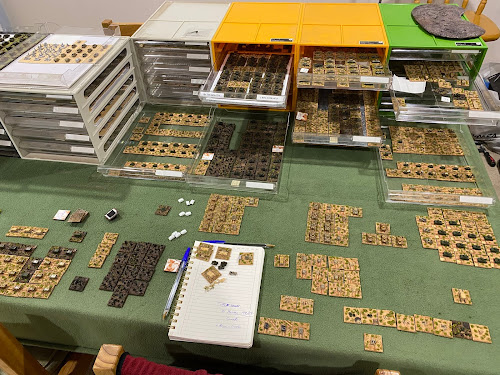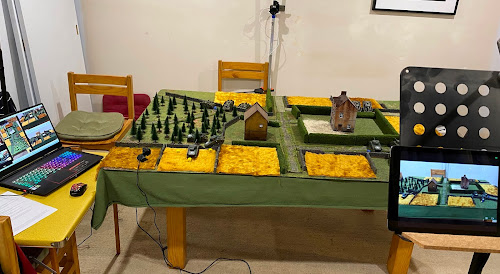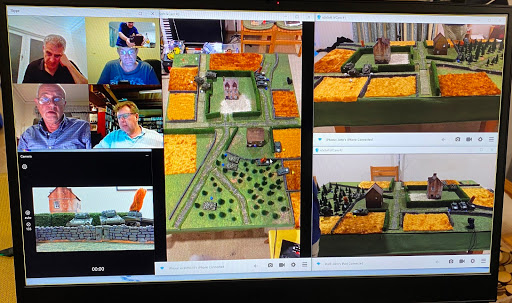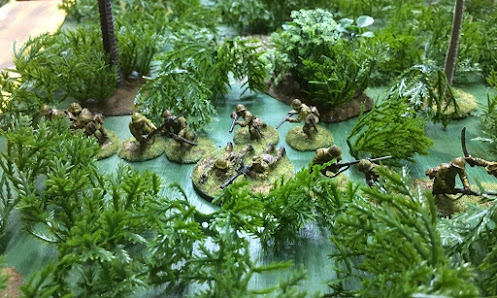A game of World War One trench warfare using 'Through the Mud and the Blood' rules by TooFatLardies. Played via Skype using 28mm figures. The remote players shared the ANZAC troops, while I taught them the rules and ran the Turkish forces.
The scenario was a night reconnaissance, with the ANZAC troops crossing No Man's Land to uncover the disposition of enemy forces.
Battles with Miniatures
Wargaming adventures and battles on the tabletop using scale miniature figures in a variety of historical, fantasy and science fiction settings.
Tuesday 2 August 2022
Gallipoli Trench Raid
Wednesday 5 August 2020
Wings of Glory - Late War
Despite Melbourne being in full winter the trees decided it was a great time to blossom. With dark, threatening clouds outside it was a great time to organise another Skype game of Wings of Glory.
This time we decided on late war. Two Sopwith Snipes against a Fokker D.VII and a high wing monoplane Fokker E.V
A very even contest with each plane taking some hits, but no prolonged bursts. My luck ran out when my E.V caught fire and slowly burnt. A Snipe was shot down shortly after, leaving just one each side.
The two remaining enemies circled each other warily, taking the occasional shot. Not easy to get other than fleeting shots, since the planes are both fast and maneouvrable.
Eventually they ran out of ideas, fuel and bullets and headed home.
Sunday 5 April 2020
3D Printing WW2 6mm for Spearhead
The organising of the British Armoured Divisions for Spearhead continued. The nice thing about having a 3D printer was that when I found I needed some models, I could just print them if the STL files were available. Most of the files I was able to get for free from Thingiverse.
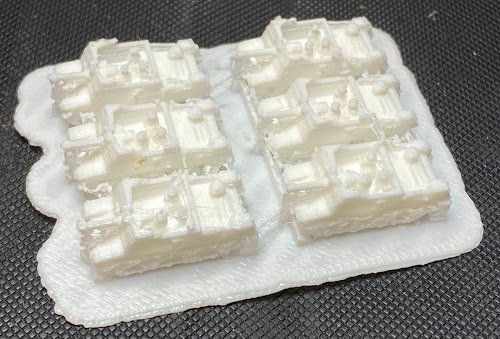 |
| Allied Sexton Self-Propelled Guns |
Here are some that I printed. The files are free. There is a huge collection made by m_bergmann on Thingiverse. The files were designed for 1:200 scale but are easily resized to 1:285. Reduced to this scale a couple might need the barrels enlarged, but surprisingly few.
I accidentally printed the first couple a 1:385 and was amazed they were still recognisable and printed fine!
A resin printer would no doubt be better, but with even with the standard 0.4mm nozzle on my nifty Flashforge Creator Pro filament printer the results are surprisingly good.
 |
| Sextons removed from the raft and cleaned up |
The great thing was that I made a list of missing vehicles as I was re-organising. Then I just set the printer going without having to wait for the models to turn up a week or a month later. 3D printing can be quite slow, especially as these need to run in high quality mode, but leave it running overnight and you have a set of models ready for you in the morning.
Here is a shot of the slicer for a group of 16 Sherman V tanks printed as separate body and turret on a raft. In the top right corner of the picture you can see it will take 7 hours 45 minutes to print all these at high resolution. Roughly 30 minutes per model.
It is important to take care when separating the barrels from the supports.
 |
| Sherman Vs ready for the paint shop |
Saturday 4 April 2020
Organising WW2 6mm British Armoured Divisions
A Saturday afternoon spent organising the WW2 British Armoured Divisions for Spearhead. Spearhead is a great set of rules that has been around a long time. It allows very large games to be played and handles single or multiple players per side with ease.
These British had originally been put together for 1942 North Africa. However, since Mike's big table is green, I decided to convert them so that the bases would be greener.
I decided to make one Armoured Division to cover the greener parts of Tunisia/Sicily/Italy. It would be set up for the 1943 British Armoured Division organisation in Spearhead but with additional figures that could morph it into 1944.
The other Armoured Division would be set up for western Europe 1944.
I last looked at these a few years ago, so I was surprised how many I actually had tucked away. Some were finished, but some were only base coated (familiar story for wargamers).
The good thing about 6mm is that you can store a lot in a small space. 6mm is the approximate height of a person. It is more generically known as micro armour. It covers both 1:285 and 1:300, although the latter is sometimes called 5mm scale.
1:285 is a scale introduced in the 1960s by the US military for training. For cast metal GHQ is considered the "Rolls Royce" due to their amazing detail, but can be quite expensive, particularly in Australia if the exchange rate to USD is not good. PFC-CinC also make in this scale. They have a very wide range.
1:300 is a scale used by NATO. Heroics & Ros, Scotia Grendel and Irregular Miniatures are popular manufacturers in this scale with wide ranges.
Increasingly available are 3D printed models, available as the STL files (many for free on sites such as Thingiverse) or as printed models from sites such as Shapeways, although the latter can be pricey.
The plastic 5-drawer units readily available from stationery suppliers make ideal and compact storage.
To keep the models organised I sticky taped some tinplate sheet which I purchased from model railway and hobby stores. Unfortunately 2 of these are not quite A4 since they are made in the USA. Another downside of the tinplate sheet is that the slightest scratch will eventually rust.
A better alternative is to get zinc-plated steel if you can get it thin enough and cut to size. Whatever you use, it must be ferrous metal so the magnet on the bases will "stick". So no good using brass, aluminium or plastic sheet.
I then have A4 paper sheets that I designed in Microsoft Excel and printed. This makes it easy to see which models I still need. Also makes choosing units and packing up at the end of a game easier. I do not bother sticking the sheet down as it only needs a couple of bases to hold it in place. It also makes it easier to replace if I change organisation or it gets torn or scuffed.
For the 30x30mm bases I use a good quality carboard or art board. Underneath I stick magnetic sheet cut to size. This holds the base in place against the metal sheet.
Monday 30 March 2020
Chain of Command - Tanks - First Skype Game
With the Covid-19 lockdown commencing in Melbourne it was important to maintain contact with club members and play some games. No webcams were currently available so I dragged out an older Microsoft webcam, which was the only one I had.
After searching the internet I found some software, ivCam, which allowed my iPhones and iPad to send a video link to the computer. Works with other smart phones, too.
With the use of a microphone stand on a chair, a music stand, a paint roller pole, some clamps and a handy roll of duct tape I set up the cameras and the game.
I talked the players through the installation and use of Skype prior to the game, which was pretty straightforward.
I wanted a game that would be easy for the remote players to give orders, with me moving the troops. I settled on a modified version of TooFatLardies Big Chain of Command. This is where I just use vehicles and is suitable for multiple players a side.
We find this game plays quicker than What a Tanker. It also has the advantage that you can add infantry, anti-tank guns and all the other goodies possible in Chain of Command.
Friday 15 June 2018
MALAYA 1942 CAMPAIGN - TURN 8
The Australians had inflicted a reverse on the Japanese, pushing them back from the vital road junction near Yong Peng. Wary of pushing too far north without safe flanks, the Australian platoon of Young Lt. Kenneth Reid halted to prepare for the inevitable Japanese counter-attack.
This was the eighth battle in the enjoyable Malaya 1942 campaign using the Chain of Command rules by TooFatLardies. Leith was looking to reverse the fortunes of the Japanese, while I was hoping the Australians could hold off the Japanese again.
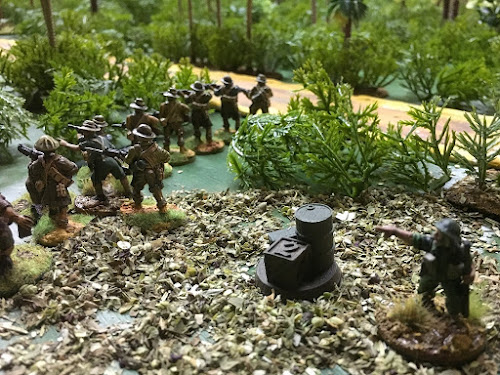 |
| Sgt. Turner directs the Australian 1st and 4th sections |
JAPANESE 6th PLATOON
Yet another new Japanese platoon was committed to battle; the sixth one for the campaign so far.
- Rikugun Yukimura led the 6th platoon in the counter-attack. He was a 29-year-old who had been fighting in China for many years.
- Gunsō Aikawa assisted him, 28-year-old cart driver from Yokohama.
- Rifle squad 1 was led by 24-year-old Gocho Naka, the fourth son of a poor family.
- Rifle squad 2 was led by Gocho Minami, a 25-year-old who left religious studies to join the army in support of the Emperor.
- Rifle squad 3 was led by the 22-year-old Gocho Sannai.
- The grenade discharger squad was led by the tall Gocho Noguchi.
AUSTRALIAN 1st PLATOON
Lieutenant Kenneth Reid’s platoon had delayed the Japanese vanguard. They had temporarily halted the Japanese in a few of the battles and now looked to push them back further from Singapore with a limited counter-attack.
The Australians had to carry the one platoon through the campaign. But with some replacements at the start of battle 6 and two recent wins, the Australians were only 1 man short. At the beginning we had not expected the Australians to have almost a full platoon so far into the campaign. A few more losses for the Australians would have seen their numbers dwindle rapidly.
- The CO’s opinion of Lt. Reid was +6. He was becoming a little arrogant. The men's opinion was good at +6, given his frequent successes.
- Sergeant Gary Turner ably assisted him.
- Corporal Brian Evans led the 1st section.
- Corporal Colin Moore led the 2nd section.
- Corporal William Colling led the 3rd section.
- Private Joseph Pentram returned from the aid station to leave the platoon only 1 man short.
MAP
For the fourth time in the campaign we were fighting on map 2. The Japanese had returned to the attack using scenario 2 from the main rule book.
SUPPORT
Leith rolled 5 points of support for the Japanese. With half of this (rounded down), +3 force difference between platoons, and +2 from the CO’s opinion, the Australians had 7 support points.
With the recent poor showing of the Japanese armour, the Australians anticipated an infantry counter-attack. They decided on an extra infantry section and the return of the Lanchester armoured car.
The Japanese chose a Type 92 7.7mm MMG team and a Type 92 70mm infantry gun for additional fire support. Due to their preparedness in the real campaign, some of their support choices are quite low cost.
Again, we kept these choices hidden from each other.
FORCE MORALE
The Japanese had a +1 adjustment to the die roll due to the campaign. The Australians had +2 due to campaign opinions. The result was the Australians starting with 10 and the Japanese with 9.
PATROL PHASE
To win this scenario the Japanese only have to get a unit off the Australian baseline or force the Australians to withdraw. To push their jump-off points as far forward as possible, Leith chose to use 3, rather than 4, patrol markers.
His roll to get 4 extra moves at the start helped with this. The Australians moved up a little and began moving around the Japanese left flank. Seeing this, the Japanese pushed forward to end the Patrol phase quickly before the Australians outflanked them.
The white circles show the position of the Japanese jump-off points and the blue circles the Australian.
BATTLE
The Australians had the first phase due to their higher Force Morale.
Turn 1 Phase 1
- A command roll of 2, 3, 4, 5, 6 allowed the Australians to deploy their 1st and 4th sections west of the road. Sergeant Turner arrived to organise them on overwatch.
 |
| Australians arrive and immediately go on overwatch |
- The Japanese responded with 1, 3, 3, 4, 5. Their 2nd rifle squad deployed just behind the jump-off point west of the road to avoid overwatch fire.
- Their 1st squad arrived just east of the road. Firing across the road allowed them to concentrate shots onto the Australian 4th rifle team for 2 kills and 1 shock. A nasty start.
Turn 1 Phase 2
- The Australians responded with a double phase. Command of 1, 2, 3, 6, 6 allowed return fire, which wounded Gocho Naka of the 1st rifle squad (-1 command point but no force morale effect).
- The 1st section moved forward but found the going slow through the jungle.
- The Australian 2nd section arrived to oppose the Japanese 1st squad, inflicting 4 shock.
Turn 1 Phase 3
- Continuing with 1, 2, 2, 5, 6 the Australians followed up with 3 kills on the Japanese 1st squad. Quite a bloodthirsty battle already.
- A command roll of 2, 2, 3, 3, 4 allowed the Japanese to bring in the 70mm infantry gun, although their opening salvo missed their enemy.
- The 2nd rifle squad moved forward but failed to hurt the Australian 4th rifle team, although the newly arrive MMG inflicted 1 kill. This was added to by the 1st rifle squad killing a Bren loader and adding 2 shock to the rifle team in the Australian 2nd section.
- The 3rd Japanese squad arrived but were not in a position to fire. Leith was taking no chances after his difficulty in deploying last time. The Japanese were arriving thick and fast.
Turn 1 Phase 4
- The Lanchester arrived. Seeing only the MMG allowed the turret machine guns to inflict 1 kill and 1 shock on them. Targeted fire from the 4th section Bren added another shock.
- Using more of the 1, 2, 3, 4, 5 gave 2 shock to the infantry gun and 1 shock to the 1st rifle squad.
- The arrival of Corporal Colling’s 3rd Australian section, near the SW corner of the village, added more shots onto the Japanese 1st rifle squad, but for no effect.
 |
| The supporting Lanchester armoured car arrives |
- The Japanese rolled a 1, 1, 1, 2, 3 which allowed them to respond aggressively. The infantry gun killed a 1st section rifleman. The MMG, aided by the Japanese 2nd rifle squad, swept the ranks of the 4th section with fire. 1 rifleman went down. 3 shock were added to the rifle team and 1 shock to the Bren team. The concentrated fire on the 4th section was taking its toll.
- Worried about the whole Japanese line being outflanked, Gocho Sannai immediately launched an attack. Moving quickly through the primary jungle, the Japanese were almost upon the Australians before they had time to respond. The ensuing melee between the aggressive Japanese and the stubborn Australians was a tough and bloody affair. No quarter was given by either side.
 |
| The Japanese 3rd squad infiltrating towards the Australian 3rd section |
- For the Japanese attackers: 13 dice from 13 men, +2 dice from Gocho Sannai, +4 dice for being aggressive (1 per 3 men) +2 dice for the Japanese LMG counting as an SMG in attack (see the Japan Island Defence platoon list for details) result in a total of 21 dice.
- For the Australians: 8 dice from 8 men (this is the section that was 1 man short in the campaign), +2 dice from Corporal Colling, +2 dice from the Japanese using 2D6 to move into range, +2 dice from the Thompson SMG, +4 dice for the Bren gave 18 dice so far. Adding 1 dice per 2 for defending heavy cover resulted in a total of 27 dice.
 |
| A close fought melee as the Australians fight off the surprise attack of the Japanese |
- Both leaders were wounded, losing a command point each, but neither affecting Force Morale.
- 7 Australians lay dead amongst 10 Japanese. The stubborn Australians received no shock, but the Japanese gained 5. They did not like fighting these strapping sons of convicts.
 |
| Despite only having 2 men left, the stubborn Australians see off the 4 surviving Japanese |
- The wounded Gocho Sannai broke with his 3 remaining men (fleeing 18” in disorder) but satisfied that Corporal Colling with just the Bren gunner were not going to cause any more problems. At great cost he had stopped the Japanese line being outflanked and inflicted severe casualties on the Australians.
- Amazingly, neither side lost any force morale from the other rolls (rifle team wiped out for the Australians and squad breaking for the Japanese). Although the Japanese had to call upon the -1 dice roll adjustment which this campaign gives them when rolling on the “Bad Things Happen” table.
 |
| Corporal Colling and a Bren gunner are all that is left of the Australian 3rd section |
Turn 1 Phase 5
- Lt. Reid was concerned with the high rate of casualties but feeling arrogant he decided to continue. A command of 1, 4, 5, 5, 6 was not great. The Lanchester could not activate and a chain of command die was close but not quite there.
- The Australian shooting was handy, but not enough to fully discomfort any of the Japanese squads or supports. Casualties continued to mount as they had for both sides so far (1 shock on the MMG, 1 kill on 1st squad, 1 kill and 1 shock on 2nd squad).
- Could the Japanese make the Australians pay for not withdrawing early enough?
- Their command roll of 3, 4, 4, 4, 6 brought on the mortars within direct line of sight of the remnants of the Australian 3rd section. They failed to finish off the duo, adding just 1 shock.
- Fire from the infantry gun inflicted 1 shock on the Bren team from the 1st section.
- The MMG continued to be effective, with a shock on the 4th section rifle team plus a kill and a shock on their Bren team. The 4th section was now pinned.
- Meanwhile, 2 shock were added to the 2nd section’s rifle team.
Turn 1 Phase 6
- Feeling a little lucky after that last phase of the battle, sense returned to Lt. Reid so he decided to withdraw. Although taking a lot of casualties, at least he had again inflicted more on the Japanese.
WRAP UP
Despite ending as a major victory to the Japanese, it was a very close battle. Mounting casualties from the start, even without the close combat. Casualties from fire and close combat in the end totalled 16 for the Japanese and 14 for the Australians. Slightly better command rolls for the Australians and Japanese in the last two phases may have seen an even higher casualty rate.
Interesting that neither side lost any force morale points, despite quite a few rolls. The jungle must have made it difficult to see far, because neither side were concerned when their leaders were injured. The -1 adjustment the Japanese get in this campaign certainly helped them with their “Bad Things Happen” rolls.
 |
| The victorious Japanese continue southward |
CAMPAIGN IMPACT
The first major victory of the campaign to the Japanese. The Australian counter-attack had run out of steam and they had been again pushed back to defend Latipah’s tea house, near the important road junction, in the next battle.
Due to the higher force morale of the Australians and the keenness of the Japanese to push on, they were unable to recover any additional men from the battlefield. They had to leave that task for following troops.
The Japanese platoon of Rikugun Yukimura would continue the attack next battle. One of the casualties was from the supporting MMG team, so his platoon would be 11 short, including the 4 missing the next battle. All the Japanese leaders continue to fight as none took 2 or more wounds.
With 5 losses being from the supporting 4th section, the Australians would be a total of 8 short (1 previous loss, 4 dead from this battle and 3 missing the next fight).
Looks likely that both sides would be a section/squad short.
Pleased by the victory, the Japanese CO’s opinion of Rikugun Yukimara rose to +2 but the men’s opinion dropped to -2 due to the butcher’s bill. His own outlook remained cheerful.
The CO’s opinion of Lt. Kenneth Reid dropped to +5, but the men’s opinion actually rose to +7. They felt they had acquitted themselves well and no longer believed in the invincibility of the Japanese. Lt. Reid was chastened by the hard fight, losing his arrogance and once again becoming heroic.
How close to Singapore could the Japanese get in the next two battles?
Friday 1 June 2018
MALAYA 1942 CAMPAIGN - TURN 7
Day 2 in the battle of Yong Peng, otherwise known to the Australian troops as the defence of Latipah’s Tea House. The Australians have fought the Japanese to a temporary standstill and are trying to push them back from shelling range of the critical Y-junction near the town of Yong Peng, just north of the island of Singapore. The Australians will be counter-attacking for the first time in the campaign.
This was the seventh battle in the engrossing Malaya 1942 campaign using Chain of Command. Fought between Leith and John using the pint-sized campaign written by Len Tracey for this great system.
 |
| Last minute cup of tea before starting the battle. The Lanchester armoured car was sent to the rear with messages for high command in case the Japanese had tanks. It was not a support for this battle |
JAPANESE 5th PLATOON
The Japanese commander was cycling through his platoons to try to break through the Australians and take Singapore. He had not been able to cause enough casualties so far in the campaign and was using the 5th platoon in the second day of this battle to replace the routed troops of the no longer secure Rikugun Yamada.
- Leading the 5th platoon was the 26-year-old Rikugun Sakurai, a cheerful professional who had been in the army for many years and felt he could do much better than Yamada.
- Aided by Gunsō Tashiro, a 24-year-old farm labourer from southern Honshu.
- Rifle squad 1 was led by 22-year-old Gocho Watabe.
- Rifle squad 2 was led by Gocho Sawada, a 23-year-old stable hand.
- Rifle squad 3 was led by the hard drinking Gocho Haneda. He had reached the grand old age of 33 and his men called him sofu (my grandfather).
- The grenade discharger squad was led by the 24-year-old Gocho Rikiishi.
AUSTRALIAN 1st PLATOON
Lieutenant Kenneth Reid’s platoon had delayed the Japanese vanguard. They had temporarily halted the Japanese in a few of the battles and now looked to push them back further from Singapore with a limited counter-attack.
The CO’s opinion of Lt. Reid was +5. He was feeling Heroic. The men's opinion was good at +4.
Sergeant Gary Turner again backed him up.
- Corporal Brian Evans returned from concussion to lead the 1st section. Acting Corporal “Billy” Brewer, who had stood in for him, returned amongst the men.
- Corporal Colin Moore still led the 2nd section
- Corporal William Colling continued to lead the 3rd section.
MAP
This was the second day of the battle on map 3, using scenario 3 from the Chain of Command rulebook. This time the Australians were counter-attacking, a new experience for them.
 |
| Malaya 1942 Campaign - Map 7 near Yong Peng |
SUPPORT
As the attacker, I rolled a 6 for support. With +3 force difference between platoons and +1 from the CO’s opinion, that gave me 10 support points for the Australians.
Leith got 3 support points from half the roll, not a lot to help his defence.
Given that no medium tanks were possible for the Japanese, I decided against a 2-pdr anti-tank gun. A light tank was unlikely given its poor showing in the previous battle, but just in case I chose a backup Boys anti-tank rifle squad. As the main support I chose 2 infantry sections to aid the counter-attack and hopefully pile the shots onto the Japanese squads.
Leith chose an MMG team with 5 men and a junior leader.
Of course, we kept these choices hidden from each other.
FORCE MORALE
The Japanese had a +1 adjustment to the die roll due to the campaign. The Australians had a +2 due to campaign opinions. The result was the Australians starting with 10 and the Japanese with 9.
PATROL PHASE
The Japanese commander initially deployed his patrol markers from the secondary jungle across to the secondary road just north of the village. Being Scenario 3 Attack & Defend from the Chain of Command rules, the Australians rolled and had 2 free moves from the baseline before the normal Patrol Phase commenced. The photo shows after the two free moves. Ignore the position of the jump-off points as these were the positions from the previous game.
 |
| Starting position for the Patrol Markers after the free moves. The jump-off points have not yet been moved from the previous day's battle |
The Japanese commander locked down the Australian patrols quickly to stop them outflanking on his right.
Leith did not want to put his jump-off points too far forward. In the unlikely event that the Australians would cross the relatively open ground around the Yong Peng outskirts, he could cover that from his eastern jump-off point. His central one was safeguarded by the secondary jungle and would allow him to deploy just forward of it in the primary jungle.
The white circles show the position of the Japanese jump-off points and the blue circles the Australian.
 |
| Patrol phase finished showing the new jump-off points |
BATTLE
With the higher Force Morale, the Australians began the counter-attack from the Y-junction. As per the “At the Sharp End” campaign supplement the Japanese chose to begin this scenario with a Chain of Command die and an emplacement. As per the Australians in the last battle, it made no sense to start with 3 emplacements in an area that was mostly hard cover. Starting with a Chain of Command die was a good option.
Turn 1 Phase 1
- An interesting start. A command roll of 3, 5, 6, 6, 6 meant the turn was over at the end of this phase and the Australians would also get the next. They brought in their 4th rifle section (one of the supports allocated to them for this battle). Since the turn was ending there was no point in putting them on overwatch.
Turn 2 Phase 1
- The Australians continued their deployment with a handy 1, 2, 3, 4, 4. Their 2nd section came in on the left of the 4th section, going on overwatch as they deployed. Sergeant Gary Turner arrived to direct the established 4th section to move forward, but only 3” tactically so as to not lose touch with their newly arrived comrades.
 |
| Australian 2nd and 4th sections deployed in the centre |
- The Australian 1st section assembled just north of Latipah’s tea house, also going on overwatch.
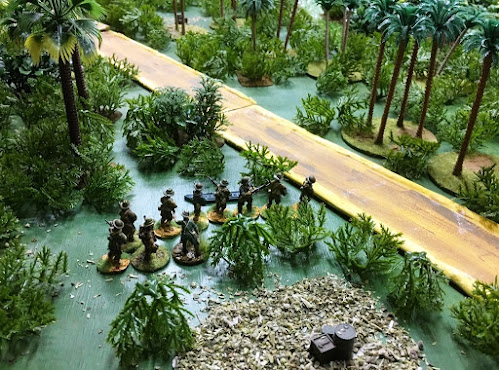 |
| The experienced Australian 1st section covers left of the main road |
- The Japanese replied with a 3, 4, 4, 5, 6 which only allowed them to bring in a supporting medium machine gun (MMG) team near the south-east corner of the secondary jungle area. Immediately they opened fire on the Australian 4th section, but they must have been still settling into position as their sole hit had no effect.
- Overwatch fire from the Bren team and 2 riflemen from the 2nd section was on target. 2 kills and 2 shock on the MMG showed the Japanese how it should be done.
 |
| Japanese MMG provides support |
Turn 2 Phase 2
- Command of 2, 3, 3, 4, 5 gave the Australians plenty of options.
- As the 4th section prepared to shoot, the Japanese interrupted using their Chain of Command die. The MMG fire killed one of the Bren team while adding a shock to the rifle team of the 4th section.
- With a shock removed, the return fire from the 4th section killed another machine gun loader as they protected the careful 5” advance of the 2nd section.
- The Australian 5th section arrived to support the other two Australian sections in the centre.
- 1, 2, 4, 5, 6 was less than the Japanese hoped for. They brought in their 1st rifle squad, in front of the secondary jungle, to supplement the fire from the MMG and spread the return fire of the Australians. Their first fire killed a rifleman from the newly arrived Australian 5th section.
 |
| Battle lines are forming with the Australians on the left and Japanese on the right |
- Gunsō Tashiro arrived to remove a shock from the MMG. His appearance inspired the crew to give 9 hits out of 10 dice on the Australian 2nd section, killing a rifleman.
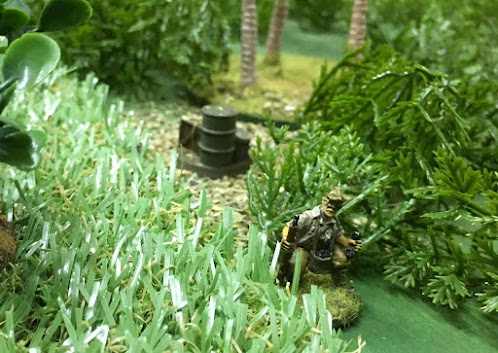 |
| Gunsō Tashiro arrives to try and stabilise the situation |
Turn 2 Phase 3
- The Japanese were put further on the back foot with the Australian command roll of 1, 2, 4, 6, 6. Another double phase to the Australians.
- Sergeant Turner transferred a rifleman to the dwindling Bren team before ordering the 4th and 2nd sections to open fire. This was solid work, resulting in 2 shock and 1 kill on the Japanese 1st rifle squad, plus the junior leader of the MMG team knocked out. The team was down to 2 active men with 2 shock. No effect on the Japanese Force Morale, though.
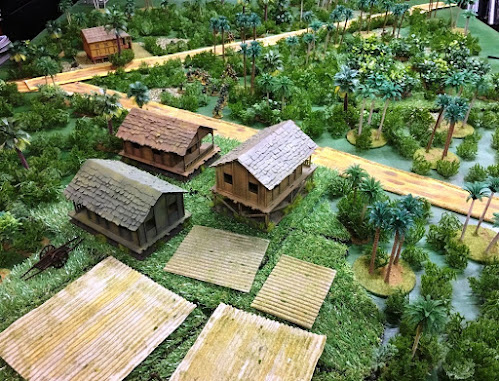 |
| View of the battlefield from the Yong Peng water tower |
- To bring more guns to bear in the centre, the Australian 5th section moved 8” forward. Now three Australian sections had the Japanese 1st rifle squad in their sights.
Turn 2 Phase 4
- The Japanese situation went from bad to worse with an Australian command roll of 2, 6, 6, 6, 6. Not only would the Australians get this phase and the next, but they got a full Chain of Command die as well as a roll on the random events table.
- Could things get any worse for the Japanese? Unfortunately, they did. A barrage from off-table mortars arrived to support the counter-attack. These landed directly on the only deployed Japanese troops, stopping their movement and plastering them with HE for two phases. Their 1st rifle squad lost 2 killed and took 1 shock, while the MMG ended pinned after losing another man killed and taking 3 shock.
- The event rolled was a random mortar barrage, which could just as easily have landed on top of the Australians or missed both sides altogether. Since it came in on top of the Japanese it made sense that it was a barrage supporting the counter-attack._
- Small arms fire added 1 kill and 1 more shock to the Japanese 1st rifle squad.
Turn 3 Phase 1
- This was the sixth phase to the Australians. The Japanese had only managed two so far.
- A 1, 3, 3, 4, 4 allowed the Australians to do everything they wanted.
- First, the barrage. 1 shock to the MMG was enough to break them. They hunkered into the jungle floor as best they could to find extra cover. They could not run because of being pinned by the barrage. A loss of 2 force morale brought the Japanese to 7.
- The barrage continued its work before lifting by adding 4 shock to the Japanese 1st rifle squad Worse was the wound to their squad leader, which left him with only 1 command point and a further drop in the Japanese force morale.
- Supporting rifle fire from the 4th section killed 2 riflemen from the 1st squad which left the latter with 7 men and 8 shock (counting as 6 shock for the Japanese). Nearly pinned.
- They also wiped out the remaining men on the MMG, causing a further drop by 2 of the Japanese force morale. Now at 4, they would only roll 4 command dice.
- Things balanced a little with the Australian 2nd and 5th sections failing to land a further blow.
- The Australian 1st section dashed across the road to threaten the right flank of the already discomforted Japanese 1st rifle squad. Most of the men made it across, but a few stragglers were still crossing the road.
 |
| The Australian 1st section crosses the road, heading for the right flank of the Japanese 1st rifle squad |
- The 2” mortar arrived behind the Tea House to fire at the enemy rifle squad, with the faint hope of pinning them, but were off target.
- Finally, a Japanese phase. Lieutenant Kenneth Reid debated whether to interrupt with his Chain of Command die to try to pin the Japanese rifle squad or save it to end the turn after reaching the jump-off points. But the shell-shocked Rikugun Sakurai decided to withdraw before the advancing Australians swamped his rifle squad and his jump-off points. He had had enough.
- With only 4 command dice, his only on-table rifle squad about to get pinned then assaulted, a wounded squad leader, his support gone and the jump-off points beginning to look too close to the Australians, there was not much hope for the Japanese.
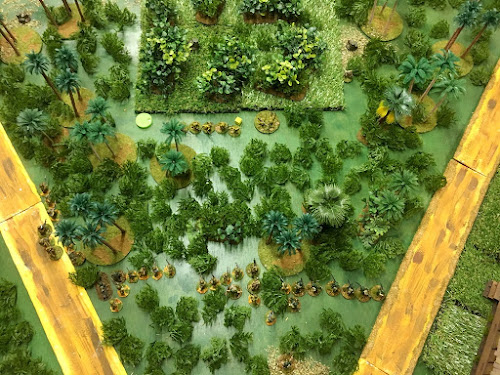 |
| Aerial view of the troops just prior to the Japanese withdrawal |
WRAP UP
The Australians pursued the Japanese hard to force them back up the road a few miles, then dug in to await the expected counter-attack. Meanwhile, the reserve units combed the battlefield. They collected their wounded and sent them back to Latipah’s Tea House for a strong cuppa.
The Australians were surprised at the ease with which they had sent the Japanese packing. So were the Japanese.
With only 2 phases for the Japanese versus 7 to the Australians they did not stand much chance. But with their large squads, the Japanese could probably still put up a good fight if it were not for the barrage. The Japanese were unlucky in that an Australian quadruple 6, followed by a double 6 followed by a random barrage, which happened to land on the Japanese, was about a 1 in 70,000 chance.
If the barrage had landed on the Australians instead, then the latter would probably have taken enough casualties to force them to withdraw from the field, due to the requirement in the campaign for the Australians to use the same platoon.
 |
| The wounded were sent back to Latipah's Tea House and a reserve platoon assembled as Lt. Reid's platoon pursue the Japanese north |
CAMPAIGN IMPACT
A major victory to the Australians. The Japanese had been pushed back to map 2. Although regaining the initiative, they have no way to win the campaign as they cannot reach map 6, let alone win a battle there, by turn 10. What they seek now is revenge on the platoon that has caused them so much trouble.
Due to the force morale difference, the Australians were able to recover all 5 men that had been put out of action (“killed”) in the battle. Losing none this battle and with 1 returning for the next battle meant that the Australian platoon was now only 1 man short. Rather unexpected.
Unsurprisingly, the CO’s opinion of Lt. Kenneth Reid rose to +6, as did the men’s opinion. Unfortunately, Lt. Reid’s own outlook became arrogant. Such responsibility and success had taken its toll on the very young Australian leader.
The Australian press were ecstatic. However, due to reverses to the east and west of this successful Australian platoon, the counter-attack had to stop after a few miles. It could not be continued without risking their flanks. The Australians would have to revert to the defensive for the next battle.
The Japanese supplies were beginning to dwindle. Lt. Reid’s platoon was buying valuable time for the improvement of the defences at Singapore. But would Percival make good use of this extra time on the island colony?
Sunday 27 May 2018
MALAYA 1942 CAMPAIGN - TURN 6
The sixth battle in the exciting Malaya 1942 campaign using Chain of Command. Fought between Leith and John using the campaign written by Len Tracey.
After a slow start, the Japanese had finally forced the Australians from map 2, in their goal of reaching Singapore quickly.
 |
| Japanese Type 95 Ha-Gō light tank |
JAPANESE 4th PLATOON
The Japanese platoon of Rikugun Yamada pushed forward to wrest control of the main road junction near Yong Peng from the Australians.
- The 4th platoon was led by Rikugun (Lieutenant) Yamada, who is feeling secure after his victory against the Australians. His commanding officer’s opinion is +1, but the men’s opinion was -2 due to the high casualties experienced in the campaign so far.
- He was ably assisted by Gunsō (Sergeant) Baba, a keen 23-year-old who was the fourth son of a shopkeeper from Tokyo.
- Rifle squad 1 was led by 29-year-old Gocho (Corporal) Sakakibara, a stone worker from Tadami.
- Rifle squad 2 was led by Gocho (Corporal) Miyazawa, a 25-year-old farmer from near Myoko.
- Rifle squad 3 was led by the reliable Gocho (Corporal) Jinnai of Takamatsu.
- Grenade discharger squad was led by the 30-year-old Gocho (Corporal) Kadokawa.
- From the core Japanese platoon, 4 missed this battle while they were recovering. 8 new faces had been drafted in from other platoons to cover the recent campaign losses. Yamada-san decided to have all 4 missing from the grenade discharger squad.
AUSTRALIAN 1st PLATOON
Young Lieutenant Kenneth Reid’s platoon had delayed the Japanese vanguard but were being pushed back towards Singapore.
- The CO’s opinion of Lt. Reid was +4. He was feeling Superior. Perhaps he was starting to be overconfident? The men's opinion was good at +2 because of the delays they were inflicting.
- Sergeant Gary Turner again provided experience for the troops.
- Corporal Brian Evans usually led 1st section but was recovering from concussion. He was replaced by William “Billy” Brewer, who had stood in for him at an earlier battle and was now respected by the men.
- Corporal Colin Moore continued to lead the 2nd section
- Corporal William Colling continued to lead the 3rd section.
- Some replacements had finally arrived from Singapore. Enough to bring the platoon back to full strength, although they were 3 men short for this battle. Two were at the first aid station. The other was the gap left by the temporary promotion of “Billy” Brewer. Reid decided to drop a man from each section for this battle.
MAP
This was the first battle on map 3, using scenario 3 from the Chain of Command rulebook. The map was the Y-intersection of the main and secondary roads near the village of Yong Peng. (In reality it may have been a large town in 1940. If so, just assume the main part of the town is just to the east of the tabletop).
3 random rolls on the campaign terrain table created the following map after random rolls for placement. A village and open area nearby made the eastern part of the table good a good defensive area. The secondary jungle in the north would cramp the attacker’s deployment; although could provide some flank protection if needed.
A compulsory building was to be added. We decided it made sense to have one near the junction to welcome weary travelers and so Latipah's Tea House came into being.
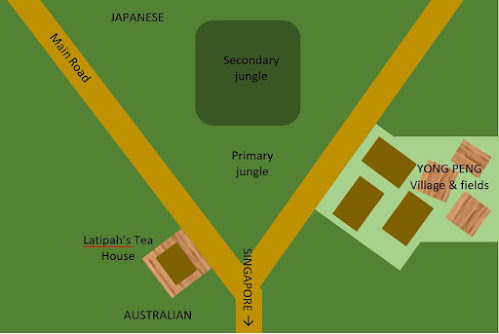 |
| Map for battle 6 - The Battle of Yong Peng |
SUPPORT
Leith rolled a 7 for support, which meant the Australians got the same (3 for platoon difference, +1 from CO’s opinion and +3 from half Leith’s roll – rounded down). Support choices were kept secret.
Possibly more Japanese tanks? I agonised over this. 8 support points would have been ideal for the Australians as that would allow a 2-pdr anti-tank gun and either an additional infantry section or a Vickers MMG to cover many possibilities. The really good supports for the Australians all cost 4 points, so 7 support points made it guesswork.
An interesting thought was to take a roadblock for each road and put them up near the Japanese table edge, so they could deploy any tanks, but not move them further down the road. Or maybe I should guard my flank with one roadblock on the secondary road only. I finally decided to call up a 2-pdr anti-tank gun and bring back the Lanchester armoured car.
If there was a medium tank the Boys anti-tank rifle was probably not enough. If I could get rid of any tanks, then the Lanchester would add some nice firepower a little way into the jungle from the road. At only 3 support points the Lanchester is a great way to get an HMG and an MMG but would be restricted to the roads and villages in this scenario. If I could not get rid of any tanks, it would be too dangerous to bring on the Lanchester, but then I probably would have to withdraw anyway.
The Japanese decided on a Type 97 Chi-Ha medium tank and a Type 95 Ha-Gō light tank. This would give them opportunities to race down the road and provide some heavy fire support.
FORCE MORALE
Each side had a +1 adjustment to the die roll. The Japanese adjustment was due to the campaign and the Australians due to Lt. Reid’s outlook. Low rolls saw the Force Morale become the opposite of the last battle, with 9 for the Japanese and 8 for the Australians.
PATROL PHASE
The Japanese commander spread his patrol groups rather wide and had trouble pushing forward as fast as he wanted. The Australians moved up as quickly as they could to try and make the secondary jungle a problem for the Japanese deployment. They were reasonably successful in this as you can see in the resulting photo, although it was always likely that the battle would be fought in the western half of the board (the left of the photo).
The white circles show the position of the Japanese jump-off points and the blue circles the Australian.
 |
| Japanese and Australian jump-off points after the patrol phase |
BATTLE
No roadblocks to deploy this time. With the higher Force Morale, the Japanese began the battle for the junction. As per the “At the Sharp End” campaign supplement from the TooFatLardies the Australians chose to begin this scenario with a Chain of Command die and an emplacement.
Turn 1 Phase 1
- A useful starting command roll of 2, 3, 3, 5, 6 for the Japanese. Making their intentions plain, they brought on a Chi-Ha medium tank on the main road and a Ha-Gō light tank on the secondary road end.
- The Australians replied with 2, 3, 5, 5, 6 starting towards a new Chain of Command die. They brought on the 2-pdr and the Boys rifle teams against the light tank, hoping to concentrate and get rid of it quickly before going after the better armoured Chi-Ha. The Boys anti-tank rifle team had to deploy in the road behind an emplacement so they could also get to fire at the light tank.
- 1 nett hit from each added 2 shock to the tank, the main gun sight damaged for the battle and the driver not able to get the tank in gear for the next phase. A good start.
 |
| Japanese Type 97 Chi-Ha medium tank |
Turn 1 Phase 2
- A 4, 5, 5, 6, 6 meant all the Japanese could do was accumulate some Chain of Command points and have another go. One or two 3s would have been handy to remove shock from the light tank and fire back at the 2-pdr.
Turn 1 Phase 3
- 1, 1, 2, 2, 6 allowed the Japanese to start the tank attack. The main gun put a shock on the 2-pdr crew but the hull machine gun failed to cause a problem.
- The medium tank raced 14” down the road towards the junction.
- A 2, 4, 5, 5, 6 continued the accumulation of Chain of Command points for the Australians and allowed the 2-pdr to put 2 nett hits on the light tank. The main gun was knocked out, dropping the Japanese Force Morale by 1.
- Sergeant Turner removed a shock from the 2-pdr. Directing the fire of the anti-tank rifle allowed them to put another nett hit on the light tank, damaging the engine. It was taking a pounding but still hanging in there. At 3 total shock it was close to the crew deciding to bail out.
 |
| The Australian Boys anti-tank rifle team supported the 2-pdr against the tanks |
Turn 1 Phase 4
- With 1, 2, 2, 3, 6 the Japanese medium tank raced another 13” down the road. The first infantry appeared on the table with rifle squad 1 and 2 arriving.
- The Australians used 1, 2, 4, 5, 6 to fire at the light tank. They Boys rifle missed but the 2-pdr finished it off with 1 nett hit – causing the crew to bail out. Losing support upset the Japanese and they lost 2 from their Force Morale. It was now down to 6.
- Ineffective fire from the Japanese overall this phase. But with them starting to mass, was this the calm before the storm?
Turn 1 Phase 5
- Lots of 1s opened up many command combinations for the Japanese with 1, 1, 1, 3, 4.
- The Japanese 1st rifle squad tried to move quickly but only managed 3”.
- The medium tank crept forward 4” and shot at the Australian 1st section, although did no damage.
- Replying with a 1, 1, 4, 5, 6 Sergeant Turner moved the Boys rifle team and the key 2-pdr team west - to try and take up position to fire on the medium tank.
- The Australian 1st section only managed a 1” tactical move. They were not able to see any opponents yet.
 |
| Having destroyed the light tank, the 2-pdr now switches to the Chi-Ha |
Turn 1 Phase 6
- A command of 1, 3, 3, 5, 6 saw the Japanese 2nd rifle squad carefully move forward 3” although they also were just short of seeing any enemy.
- The medium tank killed one of the anti-tank gunners with HE although the hull machine gun failed.
- One of the grenade discharger teams fired to no effect.
- The Australians rolled a straight with 1, 2, 3, 4, 5. The 2-pdr just missed the tank. It would have hit it if I had remembered to use 2 command points from the Sergeant to add +1 to the 2D6 roll.
- The Boys rifle team dashed across the road to find a position where they could fire without being blocked by the crew of the anti-tank gun.
- “Billy” Brewer’s 1st section landed 7 hits on the Japanese 2nd squad – resulting in 1 kill.
- The 2nd section arrived to assist, but not being able to see any targets decided to go on overwatch.
 |
| The Australians can only just see the Japanese through the jungle, but it allows them to fire |
Turn 1 Phase 7
- The duel continued with the tank. The Japanese used 1, 1, 3, 5, 6 to fire both guns to good effect. They killed one of the Boys team and added a shock. One more and they would break. They also killed a gunner from the 2-pdr team and added a shock as well.
- The grenade discharger squad were not able to contribute any casualties.
- After Sergeant Turner removed a shock, the 2-pdr clanged a round off the Chi-Ha’s turret. This rattled the crew - adding a shock and forcing the tank to reverse 3”. The Australian command of 1, 2, 2, 4, 5 also allowed the Boys to move 4” away from the edge of the road. They were now too fragile to stay in sight of the tank.
- The 2nd section moved 6” forward, bringing the Japanese 2nd rifle squad into sight but their fire was ineffective.
- The 1st section must have moved more carefully, since their reduced fire resulted in 1 kill and 1 shock on the 2nd squad.
 |
| The Japanese 2nd rifle squad takes some punishment before shooting back |
Turn 1 Phase 8
- The battle was starting to settle into a bit of a pattern, although before the Japanese could use their 3, 3, 3, 3, 4 the Australians used a Chain of Command die to interrupt for another shot at the tank, since they saw this as their biggest threat. The 2-pdr added 1 more shock and pushed the tank back another 4”.
- The Japanese responded by removing a shock and returning fire with the main gun. The Australian gunners managed to avoid casualties from the hits.
- The Japanese 1st squad made good progress through the jungle with a 9” move.
- Their 3rd squad arrived. The 2nd squad removed a shock whilst their fire placed a shock on each rifle teams within the Australian 1st and 2nd sections.
- With all his troops now involved in the battle, Rikugun Yamada arrived to personally direct the knee mortars. Their fire also placed a shock on each of the same rifle teams.
- The reply from the Australians was a double phase coming from a command roll of 1, 3, 4, 6, 6.
- The 2-pdr failed to land a hit.
- The Australian 1st section moved tactically towards the Japanese 2nd squad. With a rapid surge forward of 6” they killed a man and wounded the newly arrived Rikugun Yamada. He lost a command point and this dropped the Japanese Force Morale to 5.
- The rifle team of the 2nd section added a shock to the Japanese.
 |
| Latipah's Tea House at the junction with Yong Peng in the background |
Turn 1 Phase 9
- Continuing with 1, 2, 3, 5, 6 the anti-tank gun hit this time. The 0 nett hits provided no benefit to the Australians.
- Combined fire from the 1st and 2nd sections inflicted 2 kills and 3 more shock on Miyazawa’s squad. The 9 men left now had 4 shock in total. The large size of the squad meant that the Japanese could absorb a lot of punishment.
- The Japanese completed a Chain of Command die with a 1, 1, 3, 5, 6. A shock was removed but this failed to help the inaccurate fire from Miyazawa’s squad, even with them not counting the first 2 shock (a special campaign rule for the Japanese).
- The knee mortars finally hit something, adding a shock to each of the teams forming the Australian 2nd section.
Turn 1 Phase 10
- More fire and movement from the Australian left flank with 2, 3, 3, 4, 5 for command. The 2nd section tactically moved forward 2” although failing to inflict any damage. I rarely seem to inflict casualties from the half fire when moving tactically. At least the more limited movement kept the two sections together so that they could share casualties. Also, there is a real risk of rolling a high move on 2D6 that might put you into close combat range before you are ready.
- In Chain of Command movement distance is by dice rolls. You can designate a place to move to where there is obvious terrain, such “move up to the edge of the wood but do not go into the open”, “stop at the edge of the road”, “move to that barn”, “move up the road until you are level with the church”. Then even if you roll higher you can stop your movement there. What you cannot do is say “move to that blade of grass in the open field”, “move 6” along the road” or “stop 4.2” from the enemy” as it is not realistic for troops to be that precise. This adds to the fun as you may have to cope with troops ending up a little out of position where there are no clear landmarks.
- Whilst the 2nd section was moving, the 1st section laid down some effective fire – adding a shock as well as knocking out the injured Rikugun Yamada. His bravery had been inspiring his men but putting him in harm’s way. Japanese Force Morale was now down to 4 which meant Leith would only roll 4 command dice.
- The Chi-Ha had nothing to worry about as the AP round from the 2-pdr went wide, slamming into a tree. The 3rd Australian section of Corporal William Colling arrived to protect the anti-tank gun from the approaching Japanese of Gocho Sakakibara.
- Leith used a Chain of Command die to end the turn so that the brave Yamada-san regained consciousness.
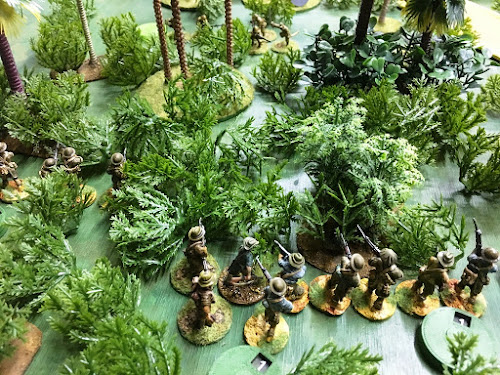 |
| Alternate fire and movement brings the Australians closer to the Japanese rifles |
Turn 2 Phase 1
- Despite only having 4 command dice, the Japanese roll of 3, 3, 4, 6 seemed quite useful. The Japanese plan was now to try and inflict casualties on the Australians to make the next battle easier. Unfortunately, the heavy fire from the 2nd squad and the grenade discharger squad inflicted no casualties on the western side of the battlefield.
- As the tank was about to fire on the 2-pdr, the latter used a Chain of Command die to interrupt with a quick shot for 2 nett hits. No shock added, but the main gun was knocked out of action. Resigned to whatever fate had in store for them, this did not to dampen the morale of the Japanese. Resorting to the hull machine gun failed to harm the Australian gun crew while the main turret was rotated to face its machine gun forward.
- Fire in the east killed a newly arrived rifleman from Colling’s 3rd section.
- A 1, 3, 3, 4, 5 brought the Australian’s just 1 off another Chain of Command die as the Boys rifle team continued to make their way back to safety. In some games you rarely see a Chain of Command dice but in this one both sides had the benefit of several.
- Despite missing the tank, the Australian small arms fire was more effective - adding 4 shock to the approaching squad of Gocho Sakakibara. The continual punishment of Gocho Miyazawa’s squad from the two Australian sections whittled it down to 8 men with 6 shock.
Turn 2 Phase 2
- With a 3, 3, 5, 5 Gocho Sakakibara ordered his 1st rifle squad to charge the Australians screening the anti-tank gun after removing a shock. Unfortunately, as they moved with purpose they fell short of engaging the Australians. Rolling 5 on 2D6 had brought the Japanese 4” short of engaging the Australians in close combat.
- A shock on the 2-pdr from the hull machine gun of the Chi-Ha, but no effect from the turret.
- Sergeant Turner removed a shock from the anti-tank gun. Knowing they had the next phase with a 2, 3, 4, 6, 6 he instructed the crew not to rush. Taking deliberate aim they responded to his short but inspirational speed – “just make sure you hit the bastard” - by smashing the tank with 4 nett hits. As the crew bailed out of the useless hulk the Japanese Force morale dropped to 3.
- Australian small arms fire killed 1 and added 1 shock to the charging 1st rifle squad, which would probably not be enough to stop them.
- The Japanese 2nd squad copped more fire. They were now down to 7 men with 9 shock (counting as 7 for the Japanese). Almost pinned. Remember in this campaign the Japanese take shock normally but discount 2 shock when determining its effect.
 |
| The Japanese crew managed to bail out of the knocked-out Chi-Ha medium tank |
Turn 2 Phase 3
- A 1, 1, 2, 2, 3 for the Australian consecutive phase allowed plenty of command combinations.
- With the tank threat eliminated, the Lanchester rattled up the road, veering left up the main road. They were hoping to pour fire into Gocho Sakakibara’s advancing squad but unfortunately did not make it far enough.
- To the west the continued fire of the Australian 2nd section brought the dwindling Japanese squad down to 6 men with 12 shock (counting as 10), nearly breaking them. Seeing this, Acting Corporal “Billy” Brewer charged his men forward.
 |
| The Australian 1st section charges home against the pinned Japanese 2nd squad |
- The advantage definitely favoured the Australians, although the Japanese put up stiff resistance. As the already wounded Rikugun Yamada unsheathed his katana to help, the Japanese ended with more dice than Leith or I expected.
- For the Japanese: 5 dice from 5 men, +2 dice from the junior leader, +2 dice from the injured senior leader, +2 dice from the Australians using 2D6 to move into range, -5 dice for the 12 shock (counting as 10), +2 dice for being aggressive (1 per 3 men), +4 dice for the LMG gave 12 dice so far. Adding 1 dice per 2 for defending heavy cover, then halving because of being pinned, resulted in a total of 9 dice.
- For the Australians: 8 dice from 8 men, +2 dice from the junior leader, +2 dice from the Thompson SMG, +2 dice for the Bren resulted in a total of 14 dice. Normally LMGs do not give the attacker extra dice, but we decided that the magazine-fed Bren would be similar to the Japanese LMG in that it can be treated as an SMG in attack. See the Japan Island Defence platoon list for details. There are plenty of accounts of the Bren being used in this manner, particularly by the Australians in the Pacific.
- The ensuing melee resulted in 3 shock to the Japanese squad, all 5 men killed, and Gocho Miyazawa losing a command point. This wounding was a bad thing for the Japanese, bringing their Force Morale down to 2. However, they seemed unconcerned by the destruction of the squad! Leith rolled a 1 which is adjusted to 0 in this campaign for the Japanese. Despite being heavily involved in the fighting, Rikugun Yamada avoided further wounds.
- Only the two Japanese leaders remained. They withdrew 12” while working out what to do next.
- “Billy” Brewer was knocked out while leading his men although this did not impact their morale. The Australians lost 2 rank and file killed. Moving forward to take the position now brought them in close range of the Japanese grenade discharger squad.
Turn 2 Phase 3
- Despite only 3 command dice, the Japanese rolled enough with 2, 2, 4. With the focus turning east of the main road the knee mortars laid some preliminary bombardment; killing a Bren loader and adding the first shock to Corporal William Colling’s rifle team.
- The squad knew what Gocho Sakakibara wanted. They advanced 5” into close combat range through the jungle. No chance of getting lost as they were within sight of the main road.
- Oops, we forgot to reduce the Japanese movement by 2” because of the 4 shock (treated as 2). This would have left the Japanese squad just 1” short of engaging in close combat. We let it stand as the Australians had used +4 dice instead of +2 for the Bren in the other combat – swings and roundabouts.
- With just one point short of a full Chain of Command die, the Lanchester was unable to interrupt the Japanese squad’s advance.
 |
| The Australians are winning west of the road as the Japanese advance to the east |
- A vigorous battle occurred between the aggressive Japanese and the stubborn Australians.
- For the Australians: 6 dice from 6 men, +2 dice from Corporal Colling, +2 dice from the Japanese using 2D6 to move into range, +2 dice from the Thompson SMG, +4 dice for the Bren gave 16 dice so far. Adding 1 dice per 2 for defending heavy cover resulted in a total of 24 dice.
- For the Japanese: 12 dice from 12 men, +2 dice from Gocho Sakakibara, -1 dice for the 4 shock (counting as 2 shock for the Japanese in this campaign), +4 dice for being aggressive (1 per 3 men) +2 dice for the Japanese LMG counting as an SMG in attack (see the Japan Island Defence platoon list for details) result in a total of 19 dice.
- Not even the jungle could shield all the men as they tried to dodge the dice with their names on them. The Japanese received 3 shock as 5 men and Gocho Sakakibara were killed. The loss of his leadership affected the Japanese force greatly. Their Force Morale bottomed out, causing the remnants of the platoon to withdraw from the field.
- In the melee they had put out of action 4 Australians from the 3rd section. Corporal Colling had been wounded, which dropped the Australian Force Morale to 7. Both teams only had 1 man left standing. With the help of the Bren gunner and the Thompson gunner, Corporal Colling searched among the fallen for any men in need of medical attention.
 |
| The Lanchester armoured car rattles past Latipah's Tea House, but is not allowed to stop |
WRAP UP
The Australians were relieved that the battle ended when it did. Because the Japanese count as aggressive they do not retreat from melee with a nett hit difference of only 1. If the Force Morale had not dropped to 0 there would have been a second round of combat and a chance to wipe out the section and/or kill the leader. Although likely that the Japanese squad would have ended pinned, any additional casualties for the Australians would have hurt them in the campaign.
- For the Australians: 2 dice from 2 men, +1 die from Corporal Colling, +2 dice from the Thompson SMG, +2 dice for the Bren would give them 7 dice.
- For the Japanese: 7 dice from 7 men, -2 dice for the 7 shock (counting as 5), +2 dice for being aggressive (1 per 3 men) +2 dice for the Japanese LMG would give them 9 dice.
The low starting Force Morale meant that both sides were brittle. Early setbacks to the Japanese Force Morale from damage to the tanks and wounds to various leaders did not help the Japanese cause. Their Force Morale dropped steadily throughout the game, even though they were not losing that many men killed.
On the western side of the battlefield, the Australians were able to dominate with 2 sections against 1 squad.
The 3rd Japanese rifle squad was too far back to be a threat. The Japanese never seemed to have the spare command to push it forward, particularly early on. I think this was mainly due to the 2 tanks chewing up most of the 3s.
Given how weak the armour is on the Ha-Gō light tank it turned out to be a liability; both from using up command dice and also from contributing to the loss of Force Morale. Mind you, this was only because the Australians chose the 2-pdr anti-tank gun for support. Had they not, it would have been a very different battle. It was certainly threatening having a tank coming down each road.
It would also have been much scarier for the Australians if the Japanese had obtained 1 more support point as this would have allowed them 2 medium tanks.
The choice of concentrating on taking out the weaker tank before turning on the medium tank worked well, despite taking longer than I had hoped.
Once again we enjoyed ourselves immensely. The more we play, the more we like Chain of Command as well as the campaign system.
 |
| The Japanese commence their withdrawal from the battlefield - but they will be back |
CAMPAIGN IMPACT
A major victory to the Australians. They can now counter-attack on this map if they wish – the first time in the campaign. That should be fun.
20 Japanese casualties in the battle of Yong Peng for the Japanese, including Gocho Sakakibara. The 2nd rifle squad was wiped out. Only their wounded Gocho was left, down to 1 command point.
Rikugun Yamada heads off to hospital and a severe interview with his commanding officer. His platoon probably will be used to provide replacements for other more successful ones.
The Australians had 10 casualties including 2 from the anti-tank support team. With a Force Morale difference of 7, they scoured the battlefield and patched up all but 3. We decided to approximately proportion these as it would be rather dodgy to take most losses from the supports. So, 1 “killed” from the 2-pdr team and 2 from the main platoon. The latter become 1 dead and 1 missing the next turn.
Since Corporal Brian Evans returns with 2 men, “Billy” Brewer will return to the ranks having gained further experience at leading a section. The lucky Australian platoon will only be 2 short: Private Martin Bowen dead and Private Joseph Pentram headed for the aid station. It could have been much worse.
The CO’s opinion of Lt. Kenneth Reid rose to +5. The men’s opinion leapt to +4. His own outlook went to heroic. Had the Australian press found a new hero amongst the debacle of the Malayan campaign? The next few battles would decide.







